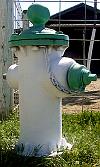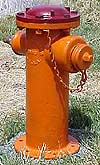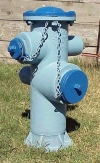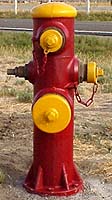Willis Lamm's Hydrant Collection
Part 1
All hydrants restored by and pictures Copyright © 2000, Willis Lamm.
| Click pictures for closeups |
Greenberg also started producing hydrants with threaded on stem guides and nozzles. Their version was designed with the classic Greenberg "frisbee top."This Model 74 hydrant was installed in Albany, CA around 1937 and remained in service until 2000. |
0604
|
Southern California used a different approach to access valves for servicing. In Los Angeles, the "LA Sleeve" was designed where the valve and stem guide could be removed using standard socket wrenches.This Greenberg Model 54GR placed in service in Pleasant Hill, CA, is a more modern example of this concept. This hydrant was removed in 1999. (Click here for another view.) |
0587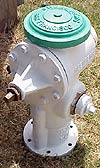
|
While Greenberg produced many different models, their most popular by far was their Model 75 which was still being produced until Greenberg was bought by Rich Valve in the late 1980s.This 1963 hydrant typified a later Model 75, with the name Greenberg cast on the bonnet. The hydrant could be ordered with a knockoff valve. A rod attached inside the bulge shown on the back view of this hydrant, which in turn kept the knockoff valve from closing.
|
0620
Click here For a back view |
In 1945 the East Bay Municipal Utility District (EBMUD) produced their own design based on Greenberg's model 71, 74 and 75 hydrants. The EBMUD stem guides fit more closely against the body providing less obstruction on sidewalks.This hydrant was in service in Orinda, CA from 1945 until 1997. (Click here for another view.) |
0588
|
|
Unless otherwise noted, all contents of these WWW pages © 1996-00, FireHydrant.org This site designed and maintained by JikTek |


